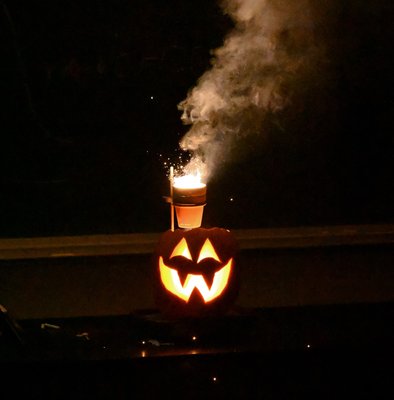Picture Perfect: Snapshots of BYU’s National Chemistry Week
Nov. 7, 2024

Dr. Stacey Smith holding methane bubbles to create huge flames.
National Chemistry Week ran from October 20th through October 26th, 2024. This public awareness campaign promoted the use of chemistry in everyday life. This year, National Chemistry Week celebrated the theme of Picture-Perfect Chemistry: exploring how chemistry plays an integral role in photography and imaging, from its earliest stages to today. Celebrations on BYU campus ran throughout the week with nitrogen ice cream sales, t-shirts, featured lectures, and magic shows from BYU professors.
One of the magic shows was presented by Dr. Stacey Smith, an associate professor of Chemistry and director of BYU’s X-ray Diffraction Facility. Dr. Smith’s magic show explained how chemistry is involved in the Lights, Camera, and Action sequences of movie making.
Dr. Smith safely showcased chemical reactions that mimicked how old cameras used certain bright flashes of light to capture photos. Gun cotton, a material used in gunpowder and fireworks, creates a large flash of light when ignited. Lighting magnesium strips produced a brilliant white light as well. Dr. Smith also used a magnesium strip to ignite iron oxide and aluminum powder, creating a violent, bright reaction that created molten iron.

In the spirit of Halloween, the molten iron reaction lights a jack o’ lantern.
Dr. Smith then explained the chemistry of cameras and film. Light reacted with silver halide crystals on the film before developing into a negative. Dr. Smith combined Tollen’s reagent (a solution of silver nitrate, ammonium hydroxide, and sodium hydroxide) and dextrose into a flask. When shaken, the flask produced a metallic silver solution.

Dr. Smith showing off her newly created silver flask.
Dr Smith then explained how different colors of light produce varying strengths of wavelengths, which we learned to capture on film as technology advanced. Digital cameras use electrons to excite sensors in the cameras, and pressing the button of a camera allows light into the sensors, telling the camera to capture the image. To help showcase the different wavelengths of light, Dr. Smith performed many colorful reactions, from pink and blue shaker bottles to the Halloween Clock, a reaction that changes a clear solution from clear, to orange, to black.

The Halloween Clock switches from orange to black.
Lastly, Dr. Smith explained how we need something to film, of course, to make a good movie. She created elephant toothpaste, shrunk balloon animals in liquid nitrogen, created a contained fire tornado, made a dollar bill nonflammable, pulled a nylon polymer thread out of a petri dish of liquid solution, and many other reactions.

Dr. Smith lighting the Y.
Thank you to everyone who supported us during this fun filled week!
Please note: All experiments shown and described in this article were safely performed by Dr. Stacey Smith with assistance from her trained students. Please do not attempt these reactions at home.
Written by: Sydney Gant
All photos provided by: Desirae Kammerman.